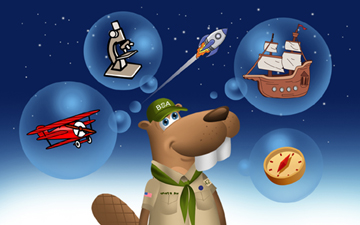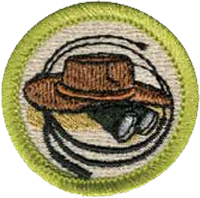Exploration


Resources
- Exploration Merit Badge Pamphlet
- Exploration Merit Badge Class Preparation Page
- Exploration Merit Badge Workbook
- Scoutmaster Bucky's Merit Badge Advancement Quick Reference
Exploration Requirements
Current Scouts BSA requirements
as of January 6, 2026
as of January 6, 2026
1.
General Knowledge. Do the following:
a.
Define exploration and explain how it differs from adventure travel,
trekking or hiking, tour-group trips, or recreational outdoor adventure
trips.
b.
Explain how approaches to exploration may differ if it occurs in the
ocean, in space, in a jungle, or in a science lab in a city.
2.
History of Exploration. Discuss with your counselor the
history of exploration. Select a field of study with a history of
exploration to illustrate the importance of exploration in the development
of that field (for example, aerospace, oil industry, paleontology,
oceanography, etc.).
3.
Importance of Exploration. Explain to your counselor why
it is important to explore. Discuss the following:
a.
Why it is important for exploration to have a scientific basis
b.
How explorers have aided in our understanding of our world
c.
What you think it takes to be an explorer.
4.
Real-Life Exploration. Do ONE of the following:
a.
Learn about a living explorer. Create a short report or presentation
(verbal, written, or multimedia slide presentation) on this individual's
objectives and the achievements of one of the explorer's expeditions.
Share what you have learned with your counselor and unit.
b.
Learn about an actual scientific exploration expedition. Gather
information about the mission objectives and the expedition's most
interesting or important discoveries. Share what you have learned with
your counselor and unit. Tell how the information gained from this
expedition helped scientists answer important questions.
c.
Learn about types of exploration that may take place in a laboratory
or scientific research facility (medicine, biology, chemistry, physics,
astronomy, etc.). Explain to your counselor how laboratory research and
exploration are similar to field research and exploration.
5.
Exploration in Lab and Field. Do ONE of the following,
and share what you learn with your counselor:
a.
With your parent or guardian's permission and counselor's approval,
visit either in person or via the internet an exploration sponsoring
organization (such as The Explorers Club, National Geographic Society,
Smithsonian Institution, American Alpine Club, World Wildlife Fund, or
similar organization). Find out what type(s) of exploration the
organization supports.
b.
With permission and approval, visit either in person or via the
internet a science lab, astronomical observatory, medical research
facility, or similar site. Learn what exploration is done in this
facility.
6.
Expedition Planning. Discuss with your counselor each of
the following steps for conducting a successful exploration activity.
Explain the need for each step.
a.
Identify the objectives (establish goals).
b.
Plan the mission. Create an expedition agenda or schedule. List
potential documents or permits needed.
c.
Budget and plan for adequate financial resources. Estimate costs for
travel, equipment, accommodations, meals, permits or licenses, and other
expedition expenses.
d.
Determine equipment and supplies required for personal and mission
needs for the length of the expedition.
e.
Determine communication and transportation needs. Plan how to keep
in contact with your base or the outside world, and determine how you
will communicate with each other on-site.
f.
Establish safety and first aid procedures (including planning for
medical evacuation). Identify the hazards that explorers could encounter
on the expedition, and establish procedures to prevent or avoid those
hazards.
g.
Determine team selection. Identify who is essential for the
expedition to be successful and what skills are required by the
expedition leader.
h.
Establish detailed recordkeeping (documentation) procedures. Plan
the interpretation and sharing of information at the conclusion of the
expedition.
7.
Prepare for an Expedition. With your parent or guardian's
permission and counselor's approval, prepare for an actual expedition to
an area you have not previously explored; the place may be nearby or far
away. Do the following:
a.
Make your preparations under the supervision of a trained expedition
leader, expedition planner, or other qualified adult experienced in
exploration (such as a school science teacher, museum representative, or
qualified instructor).
b.
Use the steps listed in requirement 6 to guide your preparations.
List the items of equipment and supplies you will need. Discuss with
your counselor why you chose each item and how it will be of value on
the expedition. Determine who should go on the expedition.
c.
Conduct a pre-expedition check, covering the steps in requirement 6,
and share the results with your counselor. With your counselor, walk
through the Scouting America SAFE Checklist for your expedition.
Ensure that all foreseeable hazards for your expedition are adequately
addressed.
8.
Go on an Expedition. Complete the following:
a.
With your parent or guardian's permission and under the supervision
of your counselor or a counselor-approved qualified person, use the
planning steps you learned in requirement 6 and the preparations you
completed in requirement 7 to personally undertake an actual expedition
to an area you have not previously explored.
b.
Discuss with your counselor about the vital role of outdoor ethics
in exploration, explaining how they promote responsible and mindful
adventuring. Explain how you applied the outdoor code, Leave No Trace
and Tread Lightly! principles during your expedition.
c.
After you return, compile a report on the results of your expedition
and how you accomplished your objective(s). Include a statement of the
objectives, note your findings and observations, include photos, note
any discoveries, report any problems or adverse events, and have a
conclusion (whether you reached your objective or not). The
post-expedition report must be at least one page and no more than three;
one page can be photos, graphs, or figures.
9.
Career Opportunities: Do ONE of the following:
a.
Explore careers related to this merit badge. Research one career to
learn about the training and education needed, costs, job prospects,
salary, job duties, and career advancement. Your research methods may
include—with your parent or guardian's permission—an internet or library
search, an interview with a professional in the field, or a visit to a
location where people in this career work. Discuss with your counselor
both your findings and what about this profession might make it an
interesting career.
b.
Explore how you could use knowledge and skills from this merit badge
to pursue a hobby. Research any training needed, expenses, and
organizations that promote or support it. Discuss with your counselor
what short-term and long-term goals you might have if you pursued this.